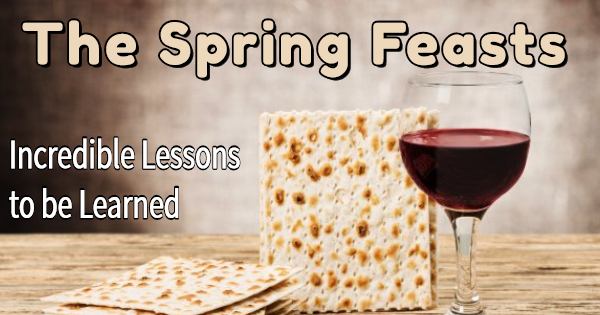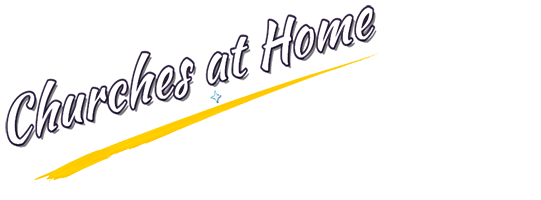
The Spring Feast: Incredible Lessons for All
I. Why do we observe these days?
A. Christ’s crucifixion and resurrection are the most important events in all of human history. The Passover (and Christ is our Passover; * Corinthians. 5:7) is an annual review of these stupendous events, wherein the source of the forgiveness of our sins is revealed.
1. Our sins are not only forgiven, but they are removed from us (Psalms 103:1-12).
2. Our sins are literally “washed away” when He forgives us (Hebrew 10:19-22, Revelation 1:5-6).
B. We want to please the One who made us by doing His will, even as Christ, the firstborn of all of us brethren, desired to do only the Father’s will (Romans 8:29; John 5:19, 30).
C. God commands us to observe them whether or not we fully understand their importance (Exodus 12:14-20; Leviticus 23:5-8). In time we will understand more and more about them.
D. At the Passover each year we are told to examine ourselves, whether we are in the faith or not (II Corinthians 13:5).
1. What is keeping you from attaining the character of God in your everyday life?
2. What is the leaven that must be cast out that resists being discovered?
3. Once leaven is cast out it still likes to return; yeast is in the air all around us, and unless the dough is protected and kept clean it can become infected and rise, becoming puffed up.
E. We are to be reminded annually of the incredible importance of the sacrifice of Jesus Christ to pay for our sins — symbolized by the bread and wine — which gives us the hope to live in the knowledge that we will someday be changed to immortal, sinless spirits (see I Corinthians 11:23-26 above; Matthew 26:26-29; Colossians 1:26-27).
F. If we have this knowledge we will be able to live without the fear of death that captivates the entire world (Romans 6:9; I Corinthians 15:54-55; II Timothy 1:8-10; Hebrews 2:14-15).
G. If we do not partake of the Passover and Holy Days we will be separated from the ecclesia (Leviticus 23:29-30; what applies to the Day of Atonement should apply to the Passover and other prescribed times; Exodus 12:13-15).
II. The Days of Unleavened Bread picture the coming out of sin.
A. Both Egypt and leavening are types of sin, which we are to be cast out before the days begin, and not partake of them during these days (Exodus 12:19-20).
B. What leavening does symbolically, in spite of it producing a nutritionally superior fermentation product:
1. Puffs up the dough, like pride does to the character … and only a humble spirit — which is the opposite of pride — can approach God (Isaiah 66:2). Thus, leavening is really government issue, of placing oneself above someone else rather than looking upon others as better than oneself as Christ did (Philippians
2-1-5). Pride separates you from God, who draws close to the humble and contrite ones (Isaiah 66:2).
2. Yeast multiplies (grows) as does sin. If you break one commandment you have broken them all (James 2:10).
3. Yeast — sin — prevents us from keeping God’s word (not obeying).
C. Israel came out of sin when they left Egypt (Exodus 12 to 15).
1. Moses was a type of Christ, a deliverer from bondage.
2. Moses pleaded with the prince of the land, the Pharaoh—a type of Satan—to let the people go, but it took 10 plagues to convince him to do so.
3. Might Satan be doing the same with the people on earth today, holding the people in bondage until through many plagues he is forced to let the people go into the Kingdom God has prepared?
4. We flee sin, but sin (the armies of Egypt) tries to catch us again to bring us back into bondage.
5. There are many sighs, pleadings, and prayers as we wait on the shore of the Red Sea, waiting for the parting of the waters so we can cross over onto the other side to freedom, while Satan’s forces are destroyed in the crashing waters; God’s forces step in to shield us from the enemy’s army and cast darkness upon the “seat of the beast” to save the saints.
6. The forces of Satan are destroyed on the seventh day … as when Satan is consigned to the bottomless pit during the seventh 1,000 years of human history.
7. As the saints cross the Red Sea they are “baptized” (I Corinthians 10:1-2).
8. The ecclesia then heads toward the heavenly abode of God (Mt. Sinai), where they meet Him face to face.
III. Bread and wine have been symbols of Christ’s body and blood throughout history.
A. In Genesis 14:17-18, the symbols of bread and wine were used by Melchisedec when Abram met him.
B. Bread and wine have always been a part of the Passover throughout history. However, the symbols were not well understood by the Israelites at the time of Christ, so He “magnified the law and made it more honorable” (Isaiah 42:21) by showing clearly what the symbols meant. Christ came to reveal the Father’s plan, that which had been hidden from ages and generations (Colossians 1:26-27; John 15:15).
IV. Bread and wine symbolize much more than just Christ’s broken body and spilled blood, but also our life in Christ and the nature of the coming Kingdom of God.
A. The bread (referring to bread made from the whole grain). It gives lots of energy and vital living — being comprised of much starch and protein, plus vitamins and minerals — so pictures the abundant life that we live in Christ in our body, mind, and spirit (John 10:10). This is the type of life that everyone will enjoy in the new age due to major changes in atmospheric oxygen levels, air pressure, magnetism of the earth, gravity, plant species for food, and so on.
B. The wine (referring to properly made, unadulterated wine). Wine “makes the heart merry” when taken in moderation (Ecclesiastes 10:19), and is very nutritious, so it symbolizes the joy of living in God’s Kingdom when the remembrance of present-day evils will be gone. In fact, Judges 9:13 states that wine cheers the hearts of both gods and men! Wine has qualities to reduce heart disease, cancer, hypertension, and many other ailments. Wine tends to make people forget their pains in the present world and better enjoy their lives … if used rightly.
C. Thus,both bread and wine picture the nature of living in the coming age!

